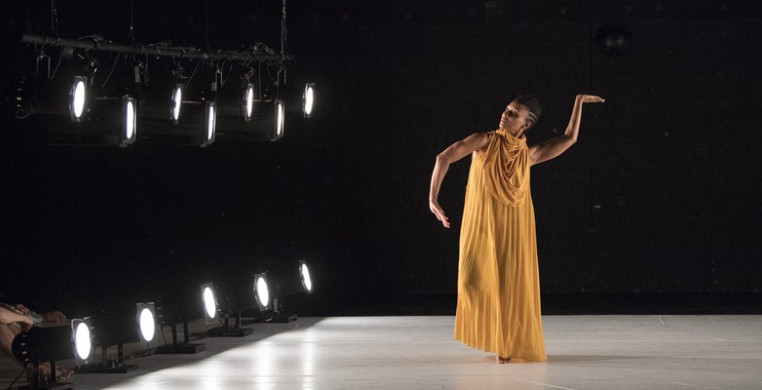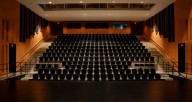Can anybody do the dance of any culture? It’s not unreasonable to believe that artists who borrow from other cultures’ secular and religious dance may have the best of intentions, but can sincerity justify any artistic choice? These questions and more are raised in “Moving alter-natives,” by French contemporary dancer and choreographer, Anne Collod, running through Feb. 15 at the MCA. “Moving alter-natives” focuses on the legacy of dancers and choreographers Ruth St. Denis and Ted Shawn, with faithful reinterpretations of their classic works but through the lenses of gender, postcolonialism and cultural appropriation.
Ruth St. Dennis and Ted Shawn, her collaborator and partner, are pioneers of American modern dance. Some regard St. Dennis’ use of Northeastern African and South Asian dance forms as an example of positive cultural exchange, citing how she brought the aesthetics of Egypt and India to the attention of Western audiences. Others make an argument that St. Dennis appropriated these cultures’ art while receiving fame and financial enrichment. The question many ask is, “What would modern dance be like without Ruth St. Dennis,” while a better question might be, “Where would modern dance be without India?”
The answer is somewhere in between, and Collod & Guests address these hot button issues the best way possible: they show more than they tell. The work is composed by Collod in collaboration with six “interpreters” of international backgrounds—Sherwood Chen, Damini Gairola, Ghyslaine Gau, Nitsan Margaliot, Calixto Neto and Pol Pi—who perform on stage this weekend. The format, with some variation, consists of audio snippets of interviews with St. Dennis and Shawn followed by interpretations of their work. The interviews provide insight on the pivotal choreographers’ motivations but also views that are misogynistic, paternalistic and insensitive to modern propriety. The dances that follow are part homage and part rebuttal as the dancers perform works by St. Dennis, like “Kashmiri Nautch” (1919), and Shawn, like an excerpt from “Kinetic Molpai” (1935), but performed in ways that the choreographers might not approve. The feminine dancers perform Shawn’s comedically masculine gestures, arms flexed akimbo, and chests brandished forward, stomping their feet and placing their fists like boxers. The masculine dancers perform St. Dennis’ work wearing flowing skirts and face-concealing hoods, their arms rippling like wafting smoke. Part tribute and part critique, the bits of biographical information and short, speculative soliloquys given by the dancers support the dancing in a harmonious balance.
The recreations of the works of St. Dennis and Shawn are presented with great care. In St. Dennis’ “Incense” (1906), dancer Ghyslaine Gau drifts slowly from side to side between waist-level rows of high-powered lamps. Gau’s arms and head morph between poses that are distinctly Egyptian, wearing a rust-colored gown that abstracts the body’s form, creating all types of geometric shapes. Dancer Pol Pi wearing a blue satin vest and pinkish skirt performs what resembles a South Indian folk dance in St. Dennis’ “Kashmiri Nautch,” with loud foot stamps and arms that are reminiscent of the style Bharatanatyam but softer. In “Lazy Nautch” (1917), dancer Sherwood Chen mesmerizes by spinning at an angle while wearing an over the shoulder white skirt with dark stripes looking like a hypnotists’ spiral—kudos to costume designer La Bourette. Shawn’s “The Dome – Sixth Prelude of the Well-Tempered Clavichord” (1933) is a work for four that looks like a study on using broad shapes, intricate patterns and precise timing to create three-dimensional optical illusions. “Decolonial Picnic,” created and performed by the ensemble, smooshes everything we’ve seen into one smorgasbord of action that begs the eye, “Keep up!”
When done right, dance and storytelling can be as effective an educational tool as the classroom, and “Moving alter-natives” does it right. Does St. Dennis’ and Shawn’s aesthetic brilliance make up for what is perhaps a callous appropriation of culture and gender? Do new ways of thinking about how we treat others detract from these works, or do they give one a deeper appreciation of their source material? Collod and guests don’t give answers to the questions they raise but leave it to the viewer to decide for themsevles.
“Moving alter-natives” runs through Feb. 15 at Museum of Contemporary Arts, 220 E. Chicago. Showtimes are Fri & Sat at 7:30pm. Tickets are $30 ($10 for students and teachers) available at mcachicago.org.


